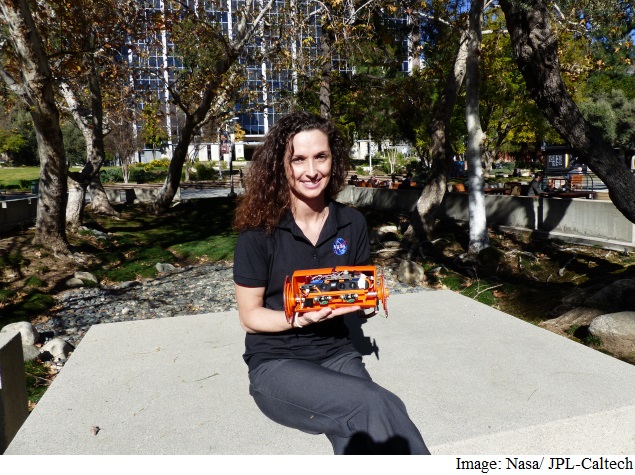- Home
- Science
- Science News
- Nasa Robot Developed to Explore Extraterrestrial Volcanoes
Nasa Robot Developed to Explore Extraterrestrial Volcanoes

The research has several implications for the study of extraterrestrial volcanoes.
On both Earth and Mars, fissures are the most common physical features from which magma erupts.
"This is probably also true for the previously active volcanoes on the moon, Mercury, Enceladus and Europa, although the mechanism of volcanic eruption - whether past or present - on these other planetary bodies is unknown," said Carolyn Parcheta, postdoctoral fellow at Nasa's Jet Propulsion Laboratory (JPL) who worked with the robot called VolcanoBot 1 in Hawaii in May 2014.
While VolcanoBot 1 was tested at Kilauea volcano in Hawaii, a lighter, smaller VolcanoBot 2 will be tested this year.
Parcheta and her co-advisor Aaron Parness, robotics researcher at JPL, are developing robots that can get into crevices where humans would not be able to go, gaining new insights about these wondrous geological features.
"We do not know exactly how volcanoes erupt. We have models but they are all very, very simplified. This project aims to help make those models more realistic," Parcheta noted.
VolcanoBot 1 was able to descend to depths of 82 feet in two locations on the fissure, although it could have gone deeper with a longer tether, as the bottom was not reached on either descent.
"In order to eventually understand how to predict eruptions and conduct hazard assessments, we need to understand how the magma is coming out of the ground. This is the first time we have been able to measure it directly, from the inside, to centimeter-scale accuracy," Parcheta pointed out.
The team plans to test VolcanoBot 2 at Kilauea in early March this year.
Catch the latest from the Consumer Electronics Show on Gadgets 360, at our CES 2026 hub.
Related Stories
- Samsung Galaxy Unpacked 2025
- ChatGPT
- Redmi Note 14 Pro+
- iPhone 16
- Apple Vision Pro
- Oneplus 12
- OnePlus Nord CE 3 Lite 5G
- iPhone 13
- Xiaomi 14 Pro
- Oppo Find N3
- Tecno Spark Go (2023)
- Realme V30
- Best Phones Under 25000
- Samsung Galaxy S24 Series
- Cryptocurrency
- iQoo 12
- Samsung Galaxy S24 Ultra
- Giottus
- Samsung Galaxy Z Flip 5
- Apple 'Scary Fast'
- Housefull 5
- GoPro Hero 12 Black Review
- Invincible Season 2
- JioGlass
- HD Ready TV
- Laptop Under 50000
- Smartwatch Under 10000
- Latest Mobile Phones
- Compare Phones
- OPPO Reno 15 Pro Max
- Honor Win RT
- Honor Win
- Xiaomi 17 Ultra Leica Edition
- Xiaomi 17 Ultra
- Huawei Nova 15
- Huawei Nova 15 Pro
- Huawei Nova 15 Ultra
- Asus ProArt P16
- MacBook Pro 14-inch (M5, 2025)
- OPPO Pad Air 5
- Huawei MatePad 11.5 (2026)
- Xiaomi Watch 5
- Huawei Watch 10th Anniversary Edition
- Acerpure Nitro Z Series 100-inch QLED TV
- Samsung 43 Inch LED Ultra HD (4K) Smart TV (UA43UE81AFULXL)
- Asus ROG Ally
- Nintendo Switch Lite
- Haier 1.6 Ton 5 Star Inverter Split AC (HSU19G-MZAID5BN-INV)
- Haier 1.6 Ton 5 Star Inverter Split AC (HSU19G-MZAIM5BN-INV)

















